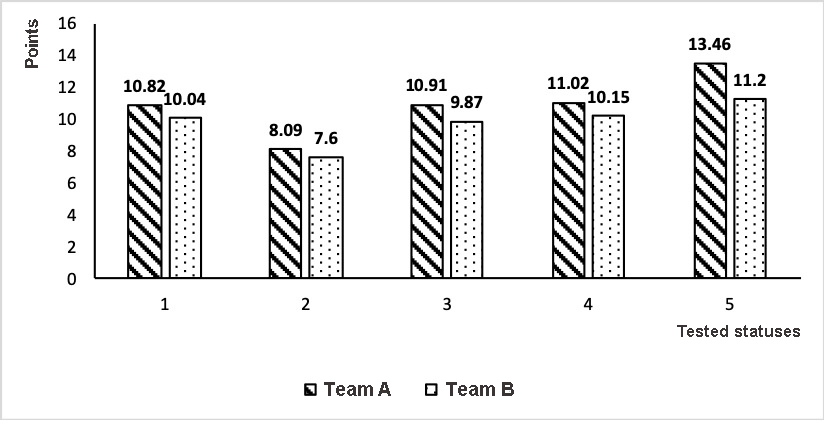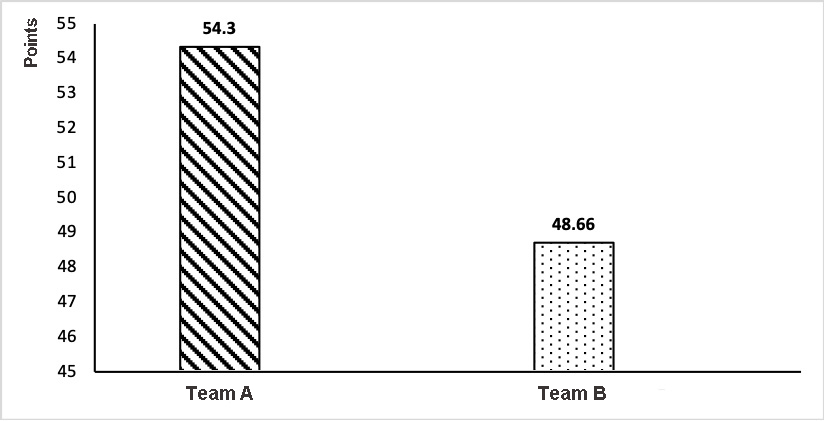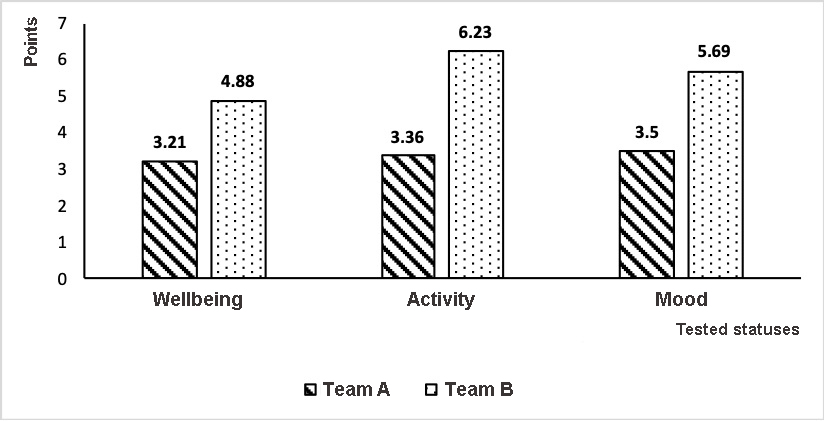Volleyball players’ mental health improvement trainings customized to ovarian menstrual cycle
ˑ:
Dr.Hab., Professor Yu.V. Baykovsky1
PhD, Associate Professor A.V. Aleshicheva2
Dr.Biol., Professor N.G. Samoylov2
PhD D.A. Kazakov2
1Russian State University of Physical Education, Sports, Youth and Tourism (SCOLIPE), Moscow
2Ryazan State Medical University n.a. Academician I.P. Pavlov, Ryazan
3Russian State Social University, Moscow
Keywords: mental health, women’s volleyball, ovarian menstrual cycle sensitive training, training system customization.
Background. In recent decades, there have appeared publications devoted to the negative changes in the health of athletes undergoing considerable physical and mental stresses [4, 5].
In this regard, it is of particular importance to study the health protection related processes in application to highly skilled athletes and especially children, young males and females. This category of athletes needs an individual approach and physical and mental loads customizable on an individual basis.
In their effort to improve athletic performance, coaches strive to increase the intensity and duration of sports trainings, which, according to a number of authors, has a negative effect on the female reproductive system [6]. Thus, some research works highlight the importance of considering specific biological characteristics of female athletes in their sports activities and especially changes in their psychological sphere during the ovarian menstrual cycle [2]. For female team players, the consideration of changes in the psychological sphere is also important from the point of view of team management [7]. Little attention is paid to studying the reactions of women’s psyche to training loads: the focus is mostly on the study of their physiological parameters [10]. On the other hand, there are mentions of the need for such studies [5, 8, 9].
Therefore, the problem of studying the changes occurring in the psyche of female athletes, particularly female volleyball players, in different phases of the ovarian menstrual cycle, as well as conscious use of physical and mental loads to maintain and strengthen their mental health, was not put forward.
Objective of the study was to profile the volleyball players’ mental health variations versus the ovarian menstrual cycles and offer the ovarian menstrual cycle customized mental health sensitive training system.
Methods and structure of the study. The study involved two teams of female volleyball players (Super League of Moscow) aged 18-20 years. The first team (A) – Control Group (n=12) – were trained without decreasing the intensity of physical and mental loads throughout the entire ovarian menstrual cycle. The second team (B) – Experimental Group (n=12) – were trained with the use of differentiated approach in load planning: in the premenstrual, menstrual and ovulatory phases of the ovarian menstrual cycle, the loads were reduced as much as possible, being replaced by technical and tactical practices. High intensity training loads were used in the postmenstrual and postovulatory phases of the cycle.
For the purposes of the study, we selected the female athletes with approximately the same duration of ovarian menstrual cycle - about 28-30 days. The experiment lasted 6 months. We applied the Gissen’s questionnaire survey [3] to obtain the subjectively rated ailments/ pains, and the WAM questionnaire [5] to rate female athletes’ wellbeing, activity, and mood. The female volleyball players’ mental health level was determined using the mental health test methods.
Results and discussion. As shown in Fig. 1, the most significant differences in the ailments were identified by the results of testing of the reproductive system of the female volleyball players (t=2.7; p=0.01). Complaints about cardiac disruptions were detected slightly less often (t=2.4; p=0.05), then followed joint pain (rheumatoid factor), debilitating symptoms (t=2.8; p<0.01), and lastly, occurring most rarely, stomach ache (t=2.2; p<0.05).

Fig.1. Subjectively rated ailments/ pains in female volleyball players (in points): 1 – debilitation; 2 – stomach ache; 3 – rheumatoid factor; 4 – cardiac pain; 5 – pain from the reproductive tract.
Mitigation of the physical and mental stresses in the ‘problematic’ phases of the ovarian menstrual cycle by tactical trainings leads to a decrease in the level of ailments/ pains in the body of female athletes (Fig. 2)

Fig. 2. Subjectively rated burden of disease (number of complaints) among female volleyball players (in points)
The WAM questionnaire proved the presence of similar, subjectively perceived changes in the psychological sphere of female athletes. Thus, the WAM rates were significantly better than in the CG (t=2.4-2.8; p<0.05-0.01).
The female athletes’ physical activity rates increased the most in the EG versus the CG (see Fig. 2) (t=2.2; p<0.05).

Fig. 3. Wellbeing, activity and mood rates in female volleyball players (in points)
The most complete picture of correlation between the training system customization and female volleyball players’ mental health was provided by the mental health test rates (see Table 1).
Table 1. Average mental health test rates in female volleyball players (in points, n=24)
|
Names of scales and indices |
Scale marking |
Groups |
Significance level |
||
|
Control |
Experimental |
t |
p |
||
|
Constructiveness scale |
А |
44.03±3.12 |
53.86±3.42 |
2.13 |
<0.05 |
|
Destructiveness scale |
В |
26.79±1.71 |
21.12±1.45
|
2.53 |
<0.05 |
|
Deficiency scale |
С |
25.51±1.76 |
19.52±1.48 |
2.61 |
<0.05 |
It was shown that the test rates on the constructiveness scale (A) (t=2.21; p=0.05) were higher in the EG (see Table 1), although on the destructiveness and deficiency scales the CG test rates, on the contrary, were higher (t=2.52; p<0.05).
The decrease in the test rates on Scale A should be interpreted as impairment in the CG subjects’ ability to tolerate high stresses in the problematic phases of the ovarian menstrual cycle in case of psychic tension. During the ovarian menstrual cycle, the CG female volleyball players demonstrated affective emotional responses, depressive states, especially when losing.
The increase in the CG destructiveness and deficiency indices (t=2.53-2.61; p<0.05) was interpreted as a display of negative changes in the psyche of the subjects, which were accompanied by excessive sensitivity to criticism, proneness to conflicts, nervousness, irritability, and verbal aggression.
The data obtained indicated mental health deterioration in the CG female volleyball players, which was accompanied by the decreased ‘psychoresistant effect’ in the problematic phases of the cycle.
Obviously, the psychological mechanism of this effect is based on the decrease in the psycho-traumatic influence of high-intensity physical and mental loads (nonpresent in the critical phases of the ovarian menstrual cycle), which results in the improvement of the protective properties of less damaged mental components and preservation of mental health of the EG female volleyball players.
Conclusions:
- The use of differentiated physical and mental loads by the female volleyball players in the premenstrual, menstrual and ovulatory phases of the ovarian menstrual cycle showed a significant decrease in the perceived pain in various body systems. This effect is designated ‘psychoresistant’, since its role is seen in increasing the female athletes’ resistance to stressful effects of training loads.
- The psychological status, expressed in such integral indicators as wellbeing, activity, and mood of the female athletes who reduced workloads in the problematic phases of the ovarian menstrual cycle improved as compared to the EG subjects.
- The ovarian menstrual cycle customized training system was tested beneficial for the maintenance of mental health of the female volleyball players. It is to be considered as an effective methodological technique, which makes it possible, through deliberate load reduction, to limit the traumatic impact on the psyche and preserve psychological health, not reducing the success of their sports activities.
References
- Abalyan A.G. Psychological and pedagogical aspects of decision making process of handball player. PhD diss. abstr.. M., 2000. 18 p.
- Peretryakhina M.A. Individualization of physical training of handball players at the stages of sports improvement. PhD diss. abstr.. M., 2009. 21 p.
- Raygorodskiy D.Ya. Practical psychodiagnostics. Methods and tests. Study guide. Samara: Bakhrakh-M publ.. 2008. 672 p.
- Ebbe A.M., Jensen S.N. Comparison of athletes’ proneness to depressive symptoms in individual and team sports: Research on psychological mediators in junior elite athletes. Frontiers in Psychology. 2016. 7(NOV). 1782.
- Lebrun C.M. The effect of the phase of the menstrual cycle and birth control pill on athletic performance. Clin.Sports Med., 1994. Vol.13(2). pp. 419-441.
- Macentyre T.E., Jones M., Brewer B.W. Editorial: Mental health challenges in elite sport: Balancing risk with Reward. Frontiers in Psychology. 2017. vol.8. art.1892.
- Plateau С.R., Petrie T.A., Papathomas A. Exercise attitudes and behaviours among retired female collegiate athletes. Psychology of Sport and Exercise. 2017. vol. 29. p.111-115.
- Shnitke R.J., Stambulova N.B., Moore Z. International society of sport psychology position stand: Athletes mental health, performance and development. International journal of Sport and Exercise Psychology. 2017. p.1-18.
- Solomon G.S., Kuhn A.W., Zuckerman S.J. Depression as a modifying factor in sport-related concussion: A critical review of the literature. Physician and Sports medicine. 2016. 44(1).p.14-19.
- Wilmore J.H., Costill D.L. Physiology of sport and exercise. Chamaign, Illinois: Human Kinetics, 2004. 726 p.
Corresponding author: alpfest@mail.ru
Abstract
Objective of the study was to profile the volleyball players’ mental health variations versus the ovarian menstrual cycles and offer the ovarian menstrual cycle customized mental health sensitive training system. The ovarian menstrual cycle customized trainings were designed to mitigate the physical and mental stresses in the ‘problematic’ (premenstrual, menstrual and ovular) phases of an ovarian menstrual cycle by the eased reasonably individualized technical and tactical trainings. The trainees’ mental statuses were tested under the study by the Gissen’s questionnaire survey to obtain the subjectively rated ailments/ pains, wellbeing, activity, mood and overall mental health rates.
The new ovarian menstrual cycle customized mental health sensitive training system was tested beneficial as verified by the following physical and mental progress in the Experimental Group (EG): falls in the subjectively rated ailments/ pains associated with the reportedly improved pain tolerance; improvements in the wellbeing, activity and mood due to the ovarian menstrual cycle -sensitive training process; and the notable competitive progress as demonstrated by the competitive success statistics for the last six month. On the whole, the EG was tested with high mental health standards due to the training system customization. The ovarian menstrual cycle -cycle-specific destructive behaviors, excessive sensitivity to criticism, proneness to conflicts, nervousness, irritability, verbal aggression etc. were kept at reasonably low levels. Therefore, the new ovarian menstrual cycle customized mental health sensitive training system was tested beneficial for the mental health maintenance and improvement purposes and, hence, for the competitive performance on the whole.



